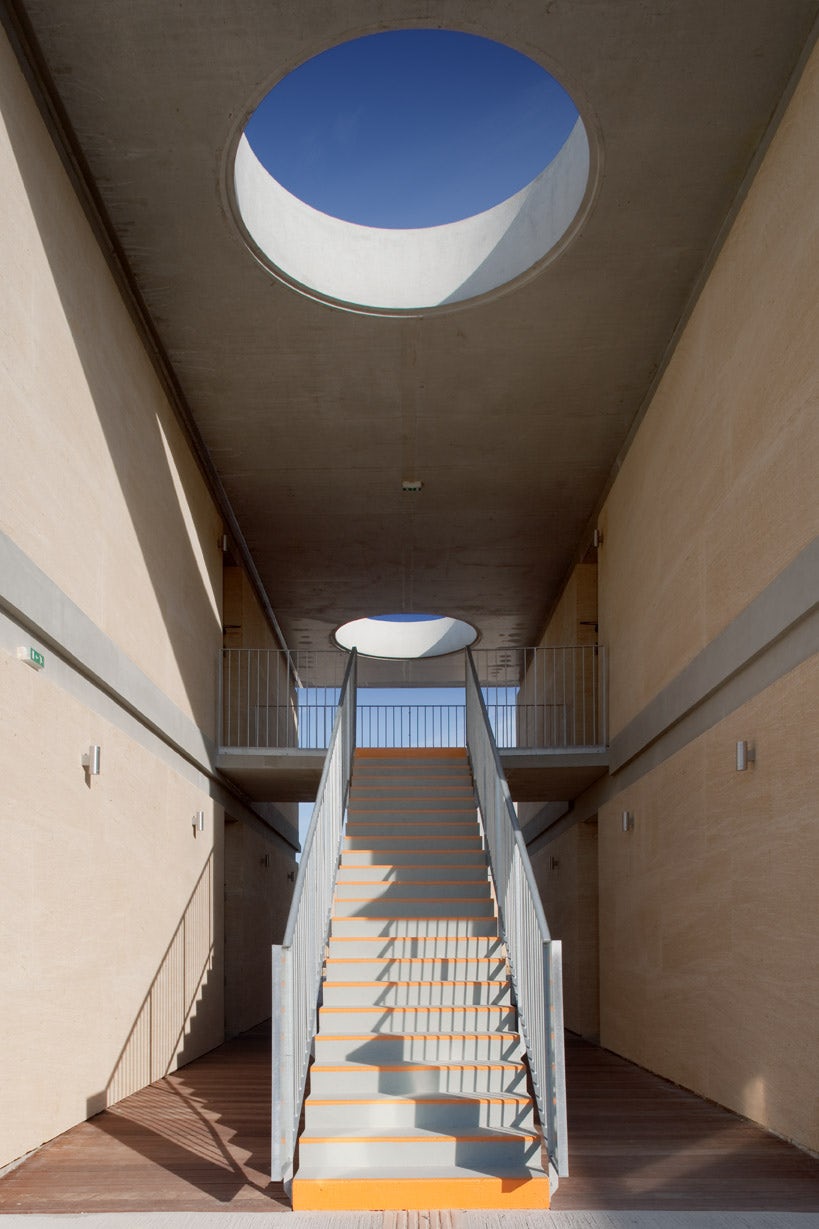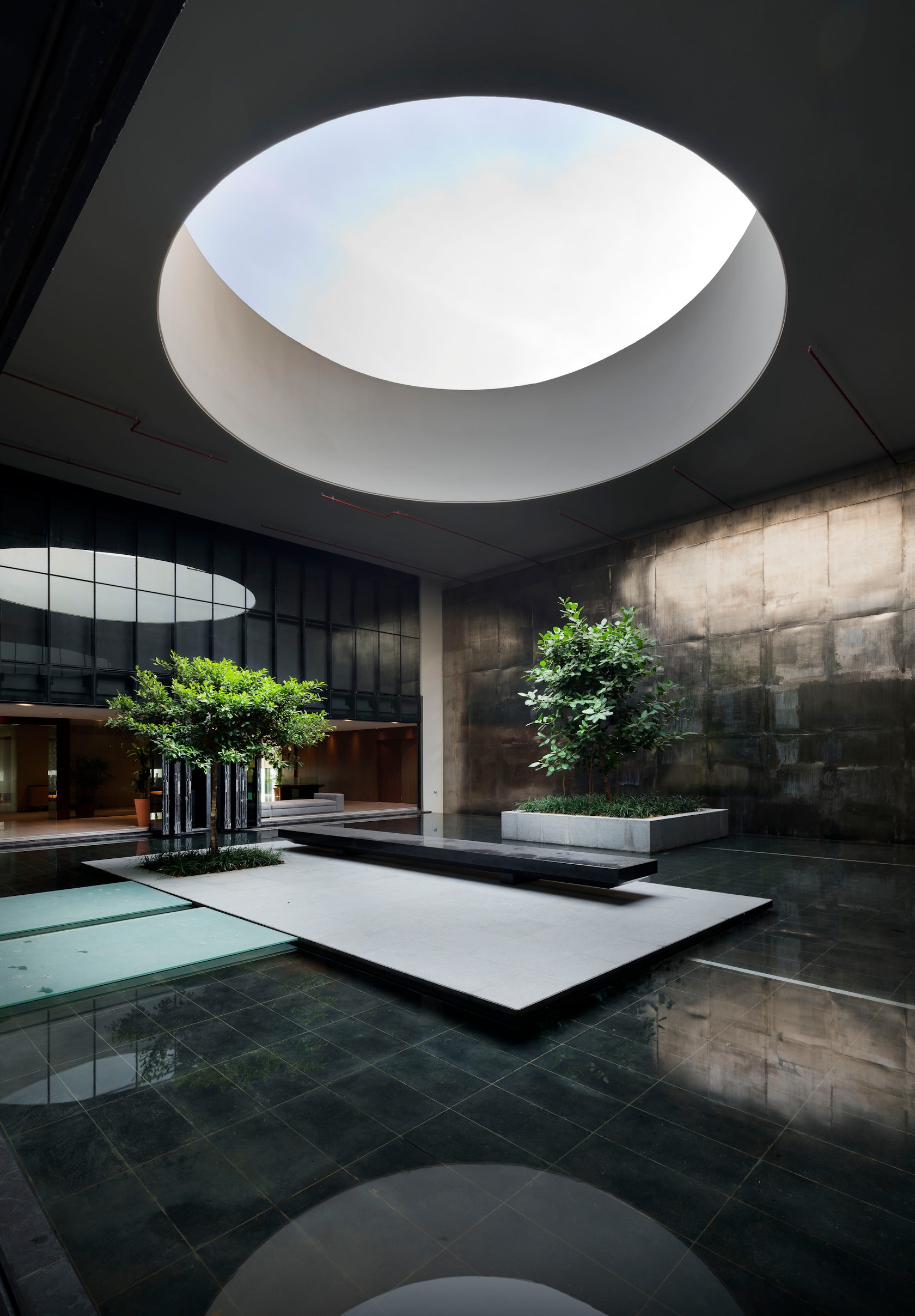An oculus is an eye of a building, generally an opening in the center of a dome or a wall that was a common feature of Byzantine and Neoclassical architecture. It allows natural light into the building, representing a sun lighting the earth. The classic oculus has since been transformed into variations of skylights incorporated into different types of buildings from churches, offices, to homes.
In contemporary architecture, the incorporation of an oculus adds a picturesque or sculptural quality to the interior, functioning both as a skylight but also as a central aesthetic feature of the building. An oculus in an interior of a building can also function as a sustainable feature for illumination for rooms that may not have other windows. The following seven projects are examples of different types and uses of oculi that are at times functional but at all times a beautiful way to light up any space.

© NBJ architects

© NBJ architects
High School in Morieres Les Avignon by NBJ architects, Morieres Les Avignon, France
The rhythmic placement of the oculi in this high school turns an otherwise cramped school hallway into a light and airy space. The oculus at the end of the stairway creates an openness when students are entering the school.

© H Lin Ho

© H Lin Ho
Setia Corporate by Archicentre Sdn. Bhd., Shah Alam, Malaysia
Much like the Pantheon, the oculus on the outside of this project allows rainwater to come through the roof and collect into the fountain. The oculus in the interior illuminates a dark walled office and creates dynamic reflections against the marble floors and the glass on the walls.

© Bunker Arquitectura

© Bunker Arquitectura

© Bunker Arquitectura
Ecumencial Chapel by Bunker Arquitectura, Cuernavaca, Mexico
This beautiful chapel was built discreetly, recessed into the ground. The roof is a metallic plate with a water pond on the top and an oculus in the center is covered with glass. Light filters in through the water and glass of the oculus, creating a shimmering effect inside the ephemeral structure.

© Arquidromo

© Arquidromo

© Arquidromo
El Domo de Tampiquito by Arquidromo, Monterrey, Mexico
Because of zoning laws, the architect was prohibited from placing windows on the front and back façades of this project. So he built a three-level oculus system. The largest opening at the top illuminates the upper loft floor and also has a spiral staircase. The light passes onto a second oculus on the floor of the loft to the floor below.

© Jensen Architects

© Jensen Architects

© Jensen Architects
Ann Hamilton Tower by Jensen Architects, Geyserville, Calif., United States
This project is a site-specific artwork imagined as a performance space. The thick concrete walls and small windows give the building a heavy and fortified look. Yet the oculus at the top illuminates the entire interior of the tower. The sky and light are reflected in a pool at the base of the tower.

© Coop Himmelb(l)au

© Coop Himmelb(l)au
Martin Luther Church by Coop Himmelb(l)au, Hainburg an der Donau, Austria
The skylights in this project are not your typical oculi. The three skylights on the roof of this church are consistent with the shapes of the steel roof. This fluid shape creates an interesting illumination of the space by playing with light and transparency, inspiring a place of mysticism and quietude.

© OAP Architektur und Projekte

© OAP Architektur und Projekte

© OAP Architektur und Projekte

© OAP Architektur und Projekte

© OAP Architektur und Projekte
James Turrell Skyspace Piz Uter by OAP Architektur und Projekte, Zuoz, Switzerland
Last but not least is a collaboration between artist and architect. This pavilion sculpture is a poetic contribution to the daylight, showing the essence of light and space in an incomparable sequence, or rather the relationship of dependence between the two.









